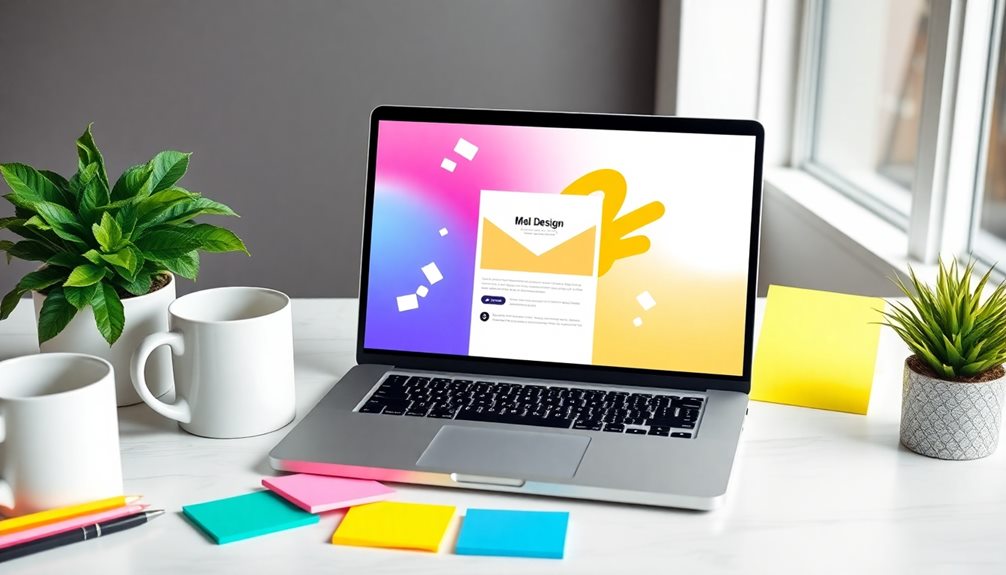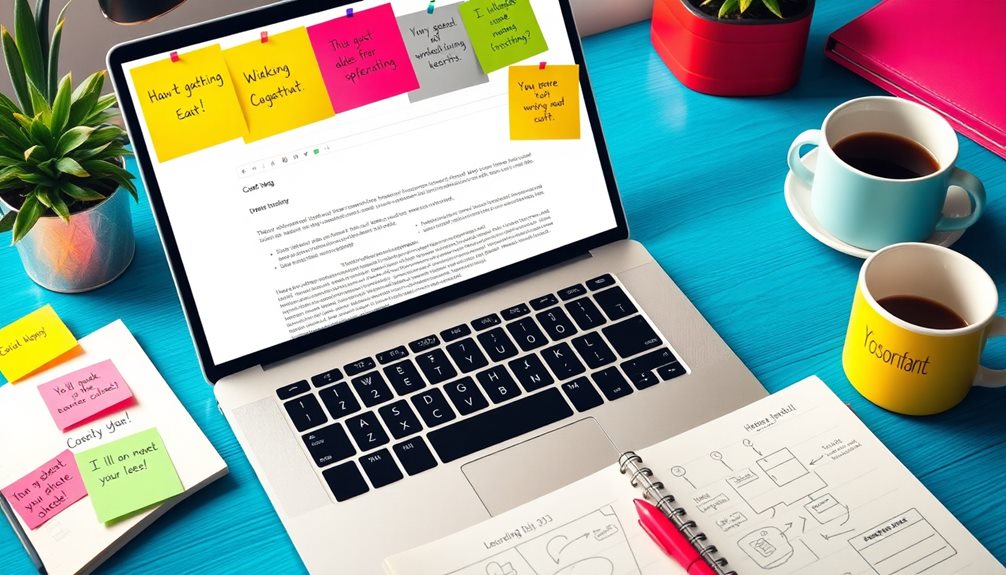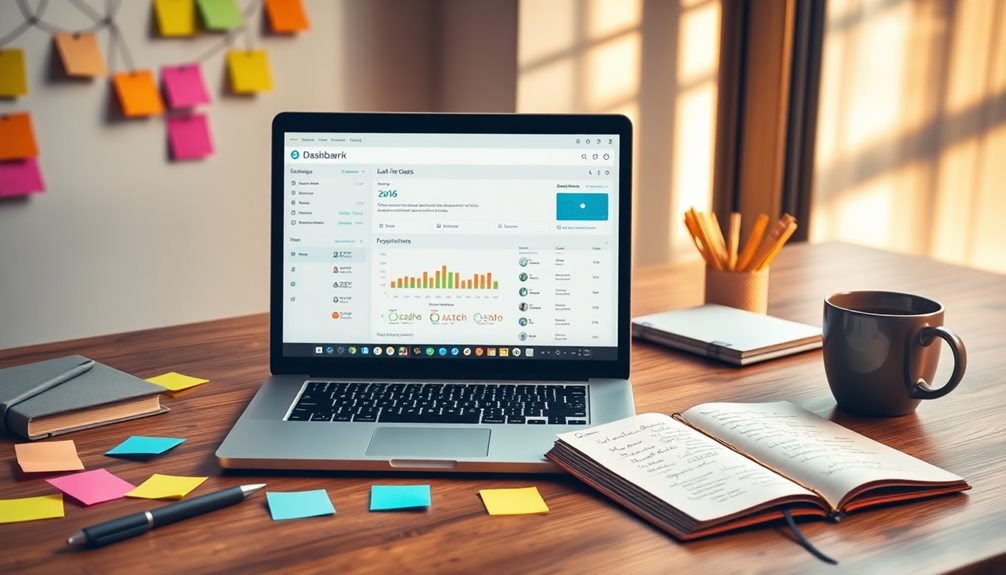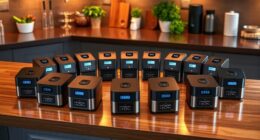To craft high-converting trigger-based emails like a pro, focus on strategic timing and personalized messaging. Start by automating responses based on user actions—like cart abandonment—to engage customers when they're most receptive. Use tailored subject lines with action-oriented language that create urgency and intrigue. Personalizing these emails can greatly boost open and click rates. Keep your content skimmable and include a single, clear call-to-action for maximum impact. Additionally, analyze engagement metrics to refine your strategy continually. Explore these tips further to reveal the secrets behind successful email campaigns that truly resonate with your audience.
Key Takeaways
- Utilize automation to send timely, personalized emails based on user actions, enhancing engagement and increasing conversion rates.
- Implement A/B testing for subject lines and content to identify what resonates best with your audience, boosting open rates significantly.
- Personalize emails by incorporating recipient names and tailored messaging to achieve higher click-through rates and foster meaningful connections.
- Craft concise and action-oriented subject lines, using strong verbs to create urgency and prompt immediate engagement.
- Analyze performance metrics regularly to refine strategies and improve engagement, ensuring emails are relevant and impactful.
Understanding Trigger-Based Emails

When it comes to email marketing, understanding trigger-based emails can really set you apart from the competition. Triggered emails are automated messages sent in response to specific user actions, like sign-ups or abandoned carts. These emails enhance engagement by being timely and relevant, which greatly boosts your open rates—some triggered emails boast rates as high as 46%.
Additionally, leveraging new technologies like Apple's AI privacy revolution can further enhance user trust and engagement through personalized content.
One of the key benefits of using triggered emails is their potential to improve conversion rates. For instance, cart abandonment emails can increase conversions by up to three times, making it critical to incorporate effective call-to-action strategies. By crafting personalized emails that resonate with your audience, you can create a more meaningful connection, ultimately driving sales.
Utilizing email automation to send these targeted messages at different stages of the customer lifecycle is a smart marketing strategy. Examples include welcome messages, reminders for abandoned carts, and follow-ups after purchases, all designed to nurture the customer journey.
Importance of Personalization

Personalization is key to making your emails stand out and drive results.
By using tailored messaging strategies and behavioral insights, you can greatly enhance engagement rates with your audience.
Incorporating relevant themes, such as essential oils for skin conditions, can create a deeper connection with your recipients.
When recipients see content that resonates with them, they're more likely to open, click, and ultimately convert.
Tailored Messaging Strategies
Effective communication is key in today's digital landscape, and tailored messaging strategies play a significant role in achieving that. High-quality content enhances credibility and trustworthiness, making personalization essential for driving results.
When you utilize segmented emails that respond to individual user actions, you can see a remarkable 58% of revenue generated through these tailored messages. Subject line personalization alone can boost open rates by 7.4%, setting the stage for effective engagement.
Furthermore, emails with personalized content can achieve an astounding 202% higher click-through rates compared to standard messages, underlining the power of targeted communication. Triggered emails, which respond directly to user behaviors and preferences, have the highest engagement rates, making them invaluable in your email marketing strategy.
It's vital to approach these strategies with a focus on the importance of content quality to maximize their effectiveness.
Behavioral Insights Utilization
Understanding customer behavior allows you to tailor your email marketing efforts more effectively. By leveraging behavioral insights, you can create triggered emails that resonate with individual users.
This kind of personalization is essential; emails that are both segmented and personalized account for a staggering 58% of revenue from email campaigns.
When you craft personalized email subject lines, you can increase open rates by an average of 7.4%. This small change can have a big impact on your overall email strategy.
Triggered emails, responding to specific user actions, boast open rates as high as 46% and click-through rates of 11%. These figures highlight the power of targeted communication, which can improve engagement rates by 30% and boost click-through rates by 50%.
Utilizing marketing automation tools to harness these behavioral insights allows you to deliver tailored calls to action that can outperform standard CTAs by a remarkable 202%.
Enhanced Engagement Rates
Engaging your audience starts with crafting messages that speak directly to their interests and preferences. Personalized emails can dramatically boost your engagement rates, with tailored messages delivering a 202% higher click-through rate compared to standard emails.
When you personalize subject lines, you see an average open rate of 18.8%, showcasing the power of customization.
To maximize your email marketing success, consider these strategies:
- Segmenting email lists based on user behavior can increase open rates by 30%.
- Triggered emails that respond to specific actions yield impressive open rates as high as 46%.
- Timely communication enhances user experience, making your messages feel relevant and immediate.
- Personalized campaigns account for 58% of revenue generated from email marketing, emphasizing the financial benefits of enhanced engagement.
Crafting Engaging Subject Lines

Crafting engaging subject lines is essential for grabbing attention in a crowded inbox.
You can boost your open rates by using action-oriented language and personalizing your messages.
Don't forget to A/B test different options to see what resonates best with your audience.
Action-Oriented Language
A strong subject line can make all the difference in your email campaigns. By using action-oriented language, you can prompt your recipients to engage immediately, capturing their attention in a crowded inbox.
Subject lines that create a sense of urgency not only increase open rates by 7.2% but also drive conversions through a clear call-to-action.
Here are some tips to craft effective subject lines:
- Use strong verbs like "Discover," "Get," or "Join" to convey intent.
- Keep your subject lines concise, ideally between 40-50 characters.
- Incorporate a sense of urgency to encourage immediate action.
- Experiment with A/B testing to identify which styles resonate best with your audience.
Incorporating action-oriented language not only enhances engagement but also improves retention in your email campaigns.
Personalization Techniques
Personalized subject lines can greatly boost your email open rates, with studies showing a 7.4% increase when messages are tailored to individual recipients. By incorporating the recipient's first name, you can enhance engagement even further, leading to 26% higher open rates.
However, keep your subject lines concise—aim for 40-50 characters. Research indicates that 64% of email decisions to open hinge on the subject line alone.
When crafting trigger-based emails, creativity is essential. Avoid generic terms like "Newsletter," which can cause an 18.7% drop in open rates. Instead, think outside the box and create intriguing subject lines that resonate with your audience.
Experimenting with different approaches can be beneficial, so consider A/B testing various personalized subject lines. This strategy helps you identify what truly resonates with your audience, driving higher engagement rates.
A/B Testing Effectiveness
Testing different subject lines can greatly enhance your email marketing results. By employing A/B testing subject lines, you can considerably boost your open rates—up to 33%—and discover what resonates best with your audience.
Here's how to maximize your effectiveness:
- Use concise subject lines, ideally between 40-50 characters, to grab attention quickly.
- Experiment with testing variations, like adding personalization or using action-oriented language, which can increase open rates by 26%.
- Keep an eye on spam triggers; emails labeled as "Newsletter" often suffer from reduced open rates.
- Regularly analyze engagement metrics to foster a stronger audience connection and improve your emails that convert.
In the domain of digital marketing, A/B testing subject lines isn't just beneficial; it's essential.
Consistently refining your approach through testing can lead to better performance over time, ensuring your emails not only reach inboxes but also engage recipients effectively.
The key is to remain adaptable, learning from each test to craft messages that resonate and drive action.
Designing Effective Email Content

How can you guarantee your email content stands out in crowded inboxes? Start by crafting clear and compelling subject lines that grab attention immediately.
Personalization is key; reference recent user actions or preferences to create a connection. This can lead to a sixfold increase in transaction rates.
Make certain your trigger emails are skimmable, using short paragraphs and visuals to enhance readability. Since over 50% of emails are opened on mobile devices, your design must be mobile-responsive. This guarantees your content looks great on any screen size.
Incorporating a strong CTA button is essential. Emails with a single CTA can see up to a 371% increase in clicks, translating to substantial revenue boosts.
Don't forget to experiment with different content formats, using educational content to provide value to your readers. Regular A/B testing of your emails can optimize engagement rates and make data-driven decisions that enhance your marketing strategies.
Timing and Frequency Strategies

Timing is essential when it comes to maximizing the effectiveness of your trigger-based emails.
You'll want to strike the right balance between timing and frequency to boost engagement and conversion rates. Studies show that sending emails on Tuesdays and Thursdays often yields higher open rates, so consider these days for your automated email sends.
To optimize your timing and frequency strategies, keep these points in mind:
- Test various email frequencies to discover what resonates with your audience.
- Monitor engagement metrics to adapt your timing based on user interactions and preferences.
- Utilize automation tools to guarantee personalized messages reach subscribers immediately after they engage with your content.
- Regularly evaluate your strategies for continuous optimization and improvement.
Analyzing Performance Metrics

Analyzing performance metrics is essential for understanding the success of your trigger-based email campaigns. Start by tracking key metrics like open rates and click-through rates (CTR).
Industry averages reveal that open rates hover around 20-30%, while CTRs range from 2-5%. These numbers give you a baseline for your triggered emails.
Utilize A/B testing to refine your strategy. Experiment with different subject lines and call-to-action placements to see what resonates best with your audience.
In fact, A/B testing can lead to a 202% improvement in personalized CTA performance.
Post-campaign, explore engagement metrics, especially for specific triggers like cart abandonment.
These emails can achieve impressive statistics, with open rates hitting up to 46% and CTRs reaching 11%.
Frequently Asked Questions
What Tools Can I Use for Trigger-Based Email Automation?
For trigger-based email automation, you can use tools like Mailchimp, ActiveCampaign, or HubSpot. They offer intuitive interfaces, automation features, and analytics to help you create effective campaigns tailored to your audience's behaviors.
How Can I Effectively Segment My Email Audience?
To effectively segment your email audience, consider demographics and behaviors. While some may respond to promotions, others prefer personalized content. Balancing these insights helps you tailor messages that resonate, increasing engagement and conversions substantially.
What Are the Best Practices for A/B Testing Emails?
To A/B test emails effectively, focus on one variable at a time, like subject lines or call-to-action buttons. Analyze engagement metrics, and always apply insights to improve future campaigns. Keep experimenting for better results!
How Can I Ensure My Emails Are Mobile-Friendly?
Imagine your carefully crafted email opening on a tiny screen, unreadable. To avoid this, use responsive design, keep your layouts simple, and guarantee buttons are large enough to tap. Test on various devices before hitting send.
What Common Mistakes Should I Avoid in Trigger-Based Emails?
When creating trigger-based emails, avoid generic subject lines, unclear calls-to-action, and excessive text. Don't forget to personalize content and guarantee your emails are mobile-friendly to engage your audience effectively and boost conversions.
Conclusion
To sum up, mastering trigger-based emails can greatly boost your engagement and conversion rates. Did you know that personalized emails deliver six times higher transaction rates? By leveraging personalization, crafting catchy subject lines, and analyzing performance metrics, you'll create compelling campaigns that resonate with your audience. Remember, it's all about connecting with your subscribers at the right moment. So, get started on your journey to crafting high-converting emails today!










